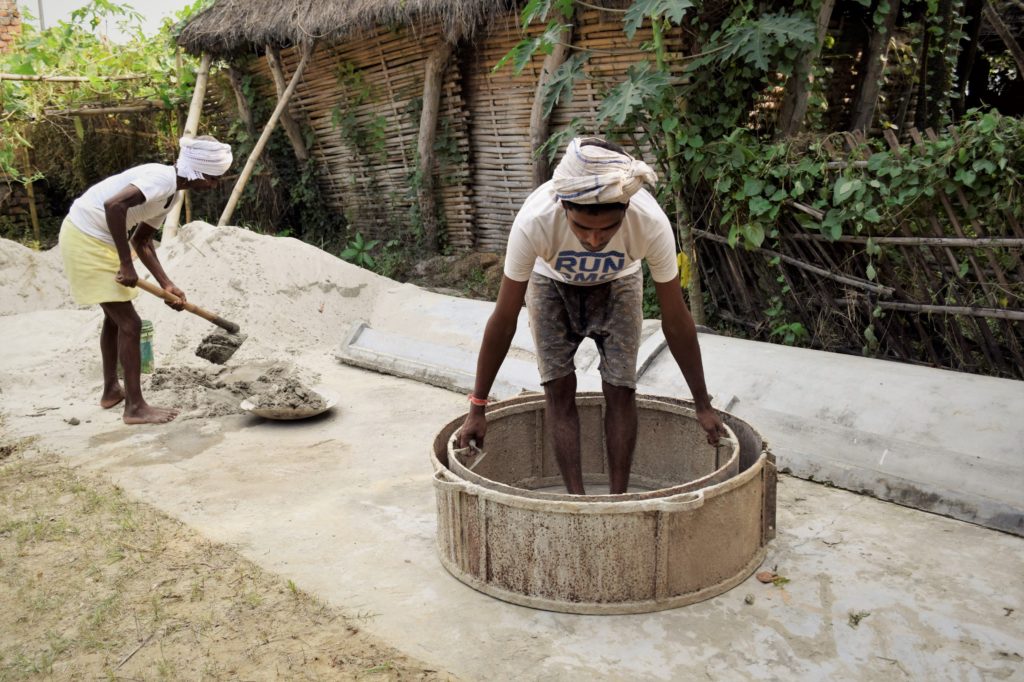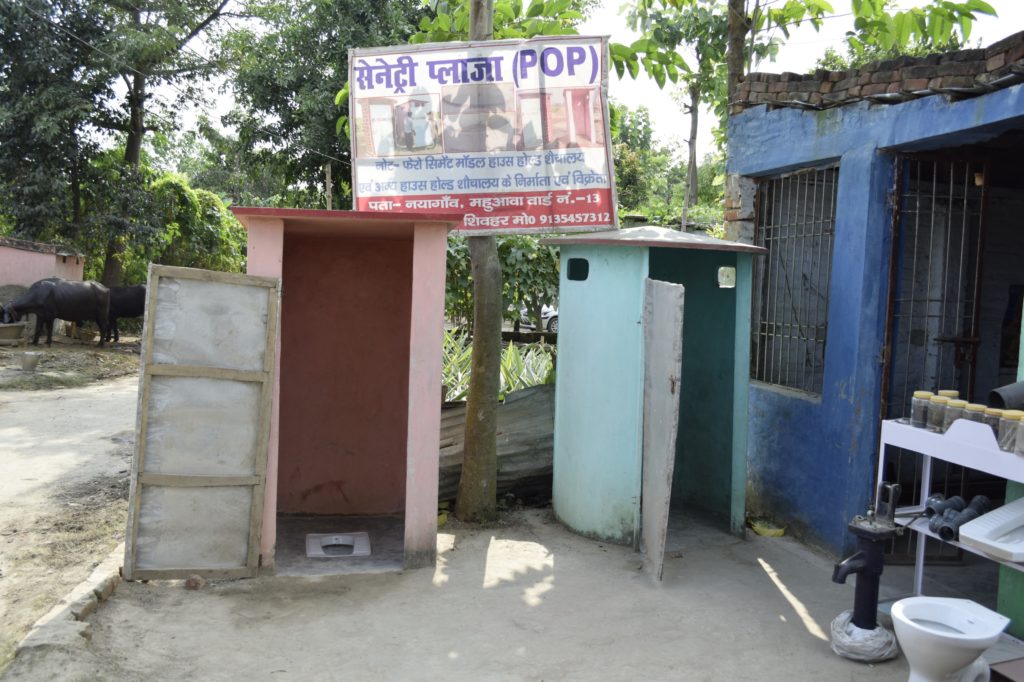By Steve Sugden, Sanitation Program Senior Manager, Water For People
Versión en español aquí.
"In the beginning, it was tough," explains Samrat Gupta, Business Opportunity Analyst with Water For People’s India Team. "We visited hundreds of households trying to sell toilets and we didn’t sell one."
This was in 2012, and Samrat was working in the Muzaffarpur district of Bihar in the North of India. His organization at the time, BASIX, was partnering with Water For People in one of our first attempts at the Sanitation as a Business model in India.
"The people just didn’t want toilets, particularly from people they did not know. They were perfectly happy defecating in the nearby fields," reflects Samrat. "We had a target of selling 50 toilets in the first six months, but by that time we had only sold one."
Dilip Kumar, Samrat’s colleague from BASIX, chimes in. "People used to abuse us verbally saying we were frauds and that we were keeping the NGO money intended to be given to the poor." Samrat asks, "How can you sell anything when your customers don’t trust you?"
Samrat is hard working and very tenacious. He, Dilip, and another colleague, Nand Kishore, decided to change direction and do something different. They were convinced it would be easier if they had a ‘product’ to sell. They thought that a family would be more likely to part with their hard-earned money if they could see and inspect what they were buying beforehand. After speaking with families, they identified that building the lining of a pit was the biggest challenge that families faced. They thought that if they could build the lining with concrete rings, as opposed to bricks, then families may just carry it forward and build a complete latrine.
They started making and selling concrete rings from the yard of their small office in 2013, and it proved to be a key turning point.
"With rings, selling toilets became easier, and we were selling 30 to 50 rings after a few months. That’s about five to seven toilets," says Dilip.
Water For People was getting our first glimpse that providing a supply chain for concrete rings had unlocked a major blockage in toilet building. There was a strong demand for toilets, but it would not be realized without the solution being permanent. Pits which were liable to collapse or filled up too quickly were simply not acceptable.
After a few months, concrete ring sales from the BASIX office began to plateau, and Samrat wanted to sell more.
"The rings are too expensive to transport long distances, and we are only supplying a small area," he complained.
They took the bold decision to abandon selling rings themselves and instead try and convince other entrepreneurs to start up small ring production factories. It was not easy, as the potential new entrepreneurs did not believe there was a strong demand for rings and were not offered any financial support for setting up costs. For businesses to succeed, the owners cannot enter the market in a halfhearted manner and must really believe in their product. Water For People has learned that if entrepreneurs have expectations that an NGO will bail them out if they run into difficulties, they will never succeed. We wanted proper businesses, not pseudo-businesses who would always depend on external donor funds and survive on a promise of "jam tomorrow."
We struggled to find entrepreneurs, and it took some gentle persuasion to eventually encourage Nand Kersher to be the first. He was working for BASIX and had seen ring sales grow, but he also realized his job was coming to an end with the new approach.
"Why not?" he said, "I have nothing else to do except farming."

Four years later, it’s 4pm and we are all sitting in a roadside restaurant waiting for our lunch to arrive. It is easy to lose track of time when visiting communities, and we are discussing the changes since the start of the program. After an initial quiet year when he only sold 30 to 40 rings a month, Nand’s business is now booming.
"Between March and August last year, I sold 400 to 500 rings a month," he beams.
This roughly translates into 35 to 50 toilets a month and represents an amazing rate of growth. He even employs four people.
"I’ve built a house, bought some land, and managed to pay for my children’s education. I’m happy," he adds.
And he is not alone. In 2018, Water For People supported cement ring supply chain growth in an additional seven districts in Bihar, all using the same principles of encouraging people to start businesses using a "light touch" approach. The approach has resulted in the construction of more than 12,500 toilets within four months alone and the establishment of more than 65 concrete ring selling businesses (sometimes referred to as Points of Purchase, or POPs).
"It is now a lot easier to convince people," admits Dilip. "They are all aware of the governments push to build latrines, and they can see how successful the other sanitation businesses have been."
Our paneer, roti, and dal are brought to the table by a beaming waiter who cannot be more than 10 years old. It tastes wonderful. I see Dilip smiling and ask him why.
"In 2012, we visited one man’s house, and he got angry with us saying we were frauds and it was the job of government and the NGOs to provide toilets for free," shares Dilip. "Last week I heard he bought a toilet."
The story reminds me of earlier today. We had visited the Minnapur Federation, an organization that manages a network of women-based self-help groups. I remembered a time in 2013 when we tried to convince them to give toilet loans to their members. They agreed, but only if Water For People provided the initial funds to build the toilets. We refused on grounds that the Federation needed to have "skin in the game." We didn’t want to set a precedent, and we didn’t have any money anyway. The disgruntled Federation responded by refusing to take part in the program. Such debates are unfortunately not unusual within the development sector and are a nasty form of poverty poker. The NGO wants to achieve results, and the local organization wants to maximize its income. On this visit, we hear that the Federation set up a cement ring business and to date has given over 8,000 toilet loans to their members, all with their own funds. I gently remind the Federation Chairman of our previous conversation. He just smiled, as did I.
The conversation around the table switches to the future. Nand thinks that the market will be good for another two to four years, after which all the homes that are going to buy a latrine will have bought one and demand will decline. He thinks a lot of the existing sanitation businesses will close, but some will continue as there will always be somebody in need of a new toilet. He is thinking there may be opportunities in supplying septic tanks or emptying latrines when they are full.
"What should Water For People do next?" I ask Samrat.
"Leave Muzaffarpur, Sir," he responds. "We have done our job, the market has changed, and it is working. Why should we stay?"
This is Samrat’s canny way of always answering a question with another question. I agree. We should remotely monitor to ensure the changes are permanent, but if we cannot add value there is no point having a presence in this area. There are many other blocks with poor ring supplies and other market failures within the sanitation sector on which to focus our scarce resources. I can also see Samrat is itching for a new challenge.
We visit another community after lunch where the village leader has ensured every home has a toilet by lending his own money to the poorer households. Very impressive and very clean. It’s getting dark, and we head back to the hotel just over an hour’s drive away. I’m quietly reflecting to myself that 32,000 toilets have been built because of this program, and households have invested over $4.8 million to build them. Rather sadly, it also means that this program builds more latrines in one month than I have managed to build in my previous 28 glorious years of working on sanitation. I wish I’d started using the market system development approach years ago and still cannot understand why other NGOs are slow in adopting this obviously better way of working.
Samrat jolts me out of my daydreaming and asks me a dreaded Samrat-style question.
"Tell me one thing, Sir. What should we be doing about slum sanitation in Kolkata?"
Samrat’s "tell me one thing" questions never involve just one thing and usually result in about three hours of discussion, but I also know it’s useless pretending to be asleep; he is far too persistent to only ask once. I’m glad that Samrat seems to have found a new market failure to focus his spreadsheet-like brain on. It should keep him occupied for a few years, and I know the final results will be impressive.
Footnote:
Water For People India is supporting Sarva Seva Samity Sanstha (SSSS), our implementation partner, with co-funding, technical inputs, and design of monitoring framework for the Jeevika-supported sanitation project "Strengthening the Rural Sanitary Mart through Capacity Building of Cluster Level Federations and Private Entrepreneurs on Sanitation Business in Rural Bihar."


